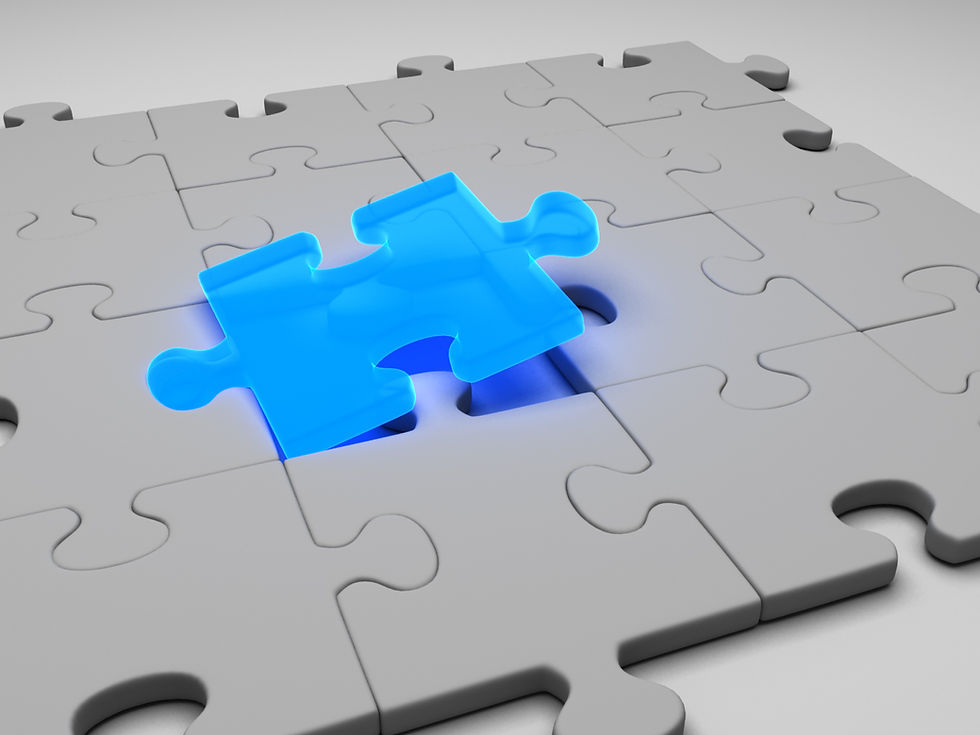Should we say no to the puzzle piece and Light It Up Blue campaigns? (Spectra.blog content)
- Kathy Carter

- Jul 2, 2022
- 4 min read
This is a blog that was originally posted at www.spectra.blog in 2020/2021. This site is being rested, and some of the content is being shared here. These are not written from a therapist's perspective, but a personal perspective.

It is still surprising how often one sees the autism puzzle piece. It’s a contentious issue in the field of autism – the puzzle piece is used as a logo to promote autism products, charities, entities and awareness events.
Conceived in 1963 by Gerald Gasson, a parent and board member for the National Autistic Society (or NAS, formerly The Society for Autistic Children), the puzzle was used as the board reportedly believed that autistic people suffered from a ‘puzzling’ condition. The NAS no longer uses it.
Many individuals nowadays object to the puzzle piece’s use in autism awareness campaigns; public opinion is fairly divided, however.
Here’s my view. The people opposing the jigsaw puzzle piece find it patronising, as if autistic individuals are part of a big puzzle that needs to be fixed. it also has connotations with an American organisation who arguably have done very little for autism acceptance.
“Bright, primary colours are hardly conducive to people with sensory challenges…”

Further criticisms about the jigsaw puzzle logo are that it is invariably shown in bright primary colours, thus linking it to children, when autism is in fact a neurology of people of all ages. Furthermore, bright, primary colours are hardly conducive to people with sensory challenges!
On the other hand, there are many people who really don’t have an opinion about the puzzle piece one way or another, or even quite like its depiction of a puzzle. Some people would argue that autism is indeed puzzling, and that the puzzle pieces represent the concept of fitting together or fitting in.
Although (judging by discussions on social media, at least), opinion does seem fairly evenly split (perhaps down to a lack of education as to WHY objectors are offended by the logo!), to generalise, it seems that most objectors to the puzzle piece are autistic adults, while those less offended are parents of autistic children, or those working in the field of autism who aren’t autistic themselves.
To infinity…

But in this enlightened time, it does seem sensible to move onto a more widely excepted logo with less historically negative links; for example the infinity logo, which represents diversity, and is much more widely preferred.
Positive steps
Recently, some autumn organisations have changed their marketing materials as a direct result of autistic individuals enlightening them as to why the puzzle pieces used may cause offence; a very positive step!
(Also, don’t take my word for it – a study titled: ‘Do puzzle pieces and autism puzzle piece logos evoke negative associations?’ which researched public perception and was published in the journal ‘Autism’ (Autism: 2018 Feb; 22(2): 118–125.) stated: ‘If an autism organization’s intention for using puzzle-piece imagery is to evoke negative associations, then the use of puzzle-piece imagery is apt. If, instead, an autism organization’s intention for using puzzle-piece imagery is not meant to devalue autistic persons, but, quite the opposite, to celebrate [autistic persons], our results suggest that puzzle-piece imagery should probably be avoided.’)
Light it up…….

Along the same lines as our observations about the puzzle piece, it is worth noting here that many autistic individuals are not fans of the ‘light it up blue’ campaigns that arise each spring, around the time of autism awareness month. Various buildings, normally backlit with plain lights, have blue filters added at the time of the campaign, as some kind of ‘tribute to’, or ‘to promote awareness of’ autism.
The origins of the concept lie with the same aforementioned American organisation that has arguably done little to promote autism acceptance.
The majority of autistic individuals (seemingly especially in the UK), who know of its origins, do NOT support the LIUB campaign, with many successfully asking project organisers who adopt the ‘light it up blue’ concept to change the filter colours, to support the neurodiversity movement.
Awareness campaigns don’t generally educate anyone about autism
In conclusion, what #actuallyautistic advocates and many families of autists crave is acceptance. All of the ‘awareness’ elements like dated puzzle piece logos and campaigns like ‘light it up blue’ do, is enhance awareness that autism exists. They don’t generally educate anyone about autism and acceptance of neurodiversity. They’re sometimes accompanied with stories of parents ‘bravely revealing’ their child is autistic, or tales of an individual ‘suffering with autism’; e.g. unhelpful language that does nothing for true awareness of the fact that autism is a lifelong processing difference.

Incidentally, the way we are exposed to autism isn’t helped by the lack of really positive influencers in the media and on social media (there are some, and they're wonderful - but it would be great to have MORE). We will all come into contact with hundreds of autists in our lifetime; autistic individuals are represented by our families, our children’s teachers, our work colleagues, etc. Everyday autistic people getting on with their lives.
A step forward for the autism community
However, in the media, references to autism are more commonly the aforementioned ‘celeb’ who ‘bravely’ discusses their autistic family member. (Not that we as a community believe that this exposure and ambassadorship is intrinsically a bad thing; of course it may not be – however, it is the negative language used, usually by presenters or journalists, that sometimes irks.).
More well-informed presenters and journalists, more #actuallyautustic advocates in the spotlight, (especially on TV), and more education all-round, in terms of acceptable ‘awareness’ campaigns and marketing assets, would definitely be a step forward for the autism community.




Comments